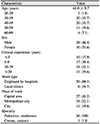1. Von Noorden GK, Campos EC. Binocular vision and ocular motility. 6th ed. Missouori: CV Mosby;2002. p. 246–297.
2. Kim SJ, Park YJ, Yoo JM. The effects of occlusion therapy in patients with anisometropic amblyopia aged 8 years and older. J Korean Ophthalmol Soc. 2010; 51:70–75.

3. Scott WE, Stratton VB, Fabre J. Full-time occlusion therapy for amblyopia. Am Orthopt J. 1980; 30:125–130.

4. Rho SS, Yang HS, Chang YH, et al. The effect on outcome of amblyopia treatment in children with anisometropic amblyopia. J Korean Ophthalmol Soc. 2007; 48:535–540.
5. Choi KW, Koo BS, Lee HY. Preschool vision screening in Korea: results in 2003. J Korean Ophthalmol Soc. 2006; 47:112–120.
6. Flom MC, Bedell HE. Identifying amblyopia using associated conditions, acuity and nonacuity features. Am J Optom Physiol Opt. 1985; 62:153–160.


7. Kim JB, Moon CS, Chang YH, et al. The amblyopia and strabismus accompanied with anisometropia. J Korean Ophthalmol Soc. 2007; 48:411–417.
8. Yeom HY, Han SH, Lee JB. Effects of solitary part-time occlusion for the treatment of monocular amblyopia patients. J Korean Ophthalmol Soc. 2004; 45:1134–1140.
9. Hussein MA, Coats DK, Muthialu A, et al. Risk factors for treatment failure of anisometropic amblyopia. J AAPOS. 2004; 8:429–434.


10. Ahn JK, Hwang JM. Efficacy of occlusion therapy in amblyopia patients older than 9 years of age. J Korean Ophthalmol Soc. 2002; 43:1724–1729.
11. Moon CS, Jin YH. Timing of amblyopia therapy in pure anisometropic amblyopia. J Korean Ophthalmol Soc. 1998; 39:185–192.
12. Choi DK, Choi MY. Efficacy of spectacles before amblyopia treatment in anisometropic amblyopia. J Korean Ophthalmol Soc. 2011; 52:550–556.

13. Hoyt C. What is next in amblyopia treatment? Ophthalmology. 2015; 122:871–873.


15. Repka MX, Beck RW, Holmes JM, et al. A randomized trial of patching regimens for treatment of moderate amblyopia in children. Arch Ophthalmol. 2003; 121:603–611.


16. Holmes JM, Kraker RT, Beck RW, et al. A randomized trial of prescribed patching regimens for treatment of severe amblyopia in children. Ophthalmology. 2003; 110:2075–2087.


17. Scheiman MM, Hertle RW, Beck RW, et al. Randomized trial of treatment of amblyopia in children aged 7 to 17 years. Arch Ophthalmol. 2005; 123:437–447.


20. Stewart CE, Moseley MJ, Stephens DA, Fielder AR. Treatment dose-response in amblyopia therapy: the Monitored Occlusion Treatment of Amblyopia Study (MOTAS). Invest Ophthalmol Vis Sci. 2004; 45:3048–3054.


21. Kim M, Choi MY. Comparison of results after daily patching and alternate-day patching to treat amblyopia. J Korean Ophthalmol Soc. 2015; 56:254–262.

22. Kraus CL, Culican SM. New advances in amblyopia therapy II: refractive therapies. Br J Ophthalmol. 2018; 102:1611–1614.











 PDF
PDF ePub
ePub Citation
Citation Print
Print





 XML Download
XML Download